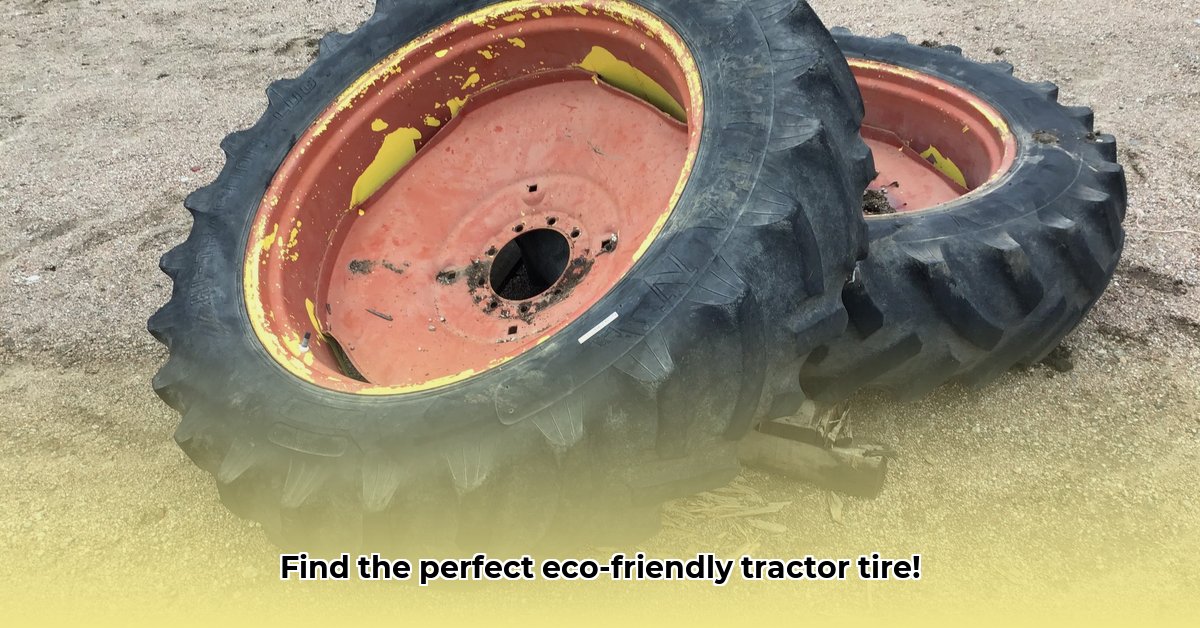
Finding the perfect 15.5 x 38 tractor tires is crucial for both your farm's profitability and environmental responsibility. This guide helps you navigate the complexities of tire selection, balancing cost-effectiveness with sustainability. We'll explore market trends, key factors to consider, and a step-by-step process to make an informed decision. For more tire size options, check out this helpful resource.
Understanding the 15.5 x 38 Tractor Tire Market
The market for 15.5 x 38 tractor tires presents a wide range of choices, with significant price variations reflecting differences in brand, materials, and performance claims. However, a major challenge is the lack of standardized sustainability metrics, making it difficult to compare the true environmental impact of different tire options. This lack of transparency makes informed, eco-conscious purchasing decisions challenging. Isn't it frustrating to lack clear data when making such a substantial investment?
Key Factors in Choosing Your Tractor Tires
Several critical factors influence your tire selection. Let's examine each to help you make an informed decision.
Brand Reputation and Performance Ratings
Established brands often demonstrate superior tire durability and longevity. However, reputation alone doesn't guarantee environmental friendliness. While performance ratings provide a benchmark for certain aspects, such as traction and load-bearing capacity, these need to be considered in tandem with other criteria. High performance may necessitate trade-offs in other areas, such as fuel efficiency or tire lifespan.
Durability and Fuel Efficiency
Durability is paramount in agricultural settings. Frequent tire replacements are costly and resource-intensive. Simultaneously, fuel efficiency is a major cost factor. Tires with lower rolling resistance translate to substantial fuel savings over time, reducing your environmental footprint and overall expenses. Did you know that tires with improved rolling resistance can cut fuel consumption by up to 10%?
Environmental Impact: Filling the Data Gap
The environmental impact of tire production, usage, and disposal is significant but often overlooked. Currently, standardized data on life-cycle assessments across brands are limited. To mitigate this gap, focus on tires made from recycled materials whenever possible, and prioritize proper tire disposal methods at the end of their lifespan. Farmers can actively reduce their environmental footprint by optimizing tire maintenance and extending their lifespan.
A Step-by-Step Guide to Choosing Your Tires
This structured approach will guide you through the tire selection process:
Budgeting and Needs Assessment: Define your budget, considering not just the initial purchase price but also long-term costs such as replacements, fuel consumption, and disposal. Assess your farm's specific needs in terms of soil conditions, workload, and operational requirements.
Research and Comparison: Research different brands and models of 15.5 x 38 tires. Carefully analyze specifications, paying attention to aspects such as load capacity, rolling resistance, and tread design. Consult online reviews alongside manufacturer's data.
Evaluating Performance and Longevity: Assess performance ratings critically. While these can be insightful, consider the trade-offs involved. Prioritize durability to avoid frequent replacements.
Long-Term Cost Analysis: Evaluate the total cost of ownership (TCO) by considering annual depreciation, fuel savings, maintenance, and disposal costs. This holistic approach helps you choose the most cost-effective solution in the long run.
Sustainability and Responsible Farming Practices
The environmental impact of tires is multifaceted, encompassing the production process, operational fuel consumption, and end-of-life disposal. Manufacturers need to embrace greater transparency regarding their sustainability measures. Farmers, in turn, can actively contribute by prioritizing proper tire maintenance and exploring environmentally friendly disposal options.
Actionable Recommendations for Stakeholders
This table summarizes key actions for various stakeholders:
| Stakeholder | Key Actions |
|---|---|
| Farmers | Prioritize durability, opt for fuel-efficient tires, practice responsible disposal |
| Manufacturers | Publish comprehensive sustainability data, adopt sustainable manufacturing practices |
| Researchers | Develop standardized sustainability metrics, conduct life-cycle analyses |
| Government Agencies | Offer incentives for sustainable tire choices, implement responsible disposal regulations |
Conclusion: Making Informed Decisions
Choosing the right 15.5 x 38 tires for your tractor requires careful consideration. By following this guide and weighing the factors discussed, you can make a well-informed decision that optimizes both your farm's financial performance and its environmental footprint. Remember, this is an area of continuous improvement, and our understanding of tire sustainability is constantly evolving. Embrace informed purchasing to benefit both your farm and the environment.